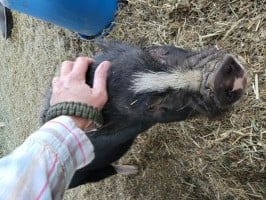
FLEA ON DOGS
32SHARES358VIEWSShare on TwitterShare on Facebook We all know that flea

We all know that flea and ticks cause a lot of harms to our beloved pets. Thankfully, there are a lot of things one can do to deal with these pesky little parasites. How much do you really know about these dangerous parasites?
The soft, warm fur of dogs provide a conducive environment for fleas. This parasites feed on your pets blood causing health problems ranging from allergic reactions to serious tick-borne illness. This insect is common during the warmer months.
Flea Lifecycle
Fleas on dogs can really make life unbearable for your pet. Fleas are small wingless insects that feeds on animal blood. This pesky parasites transmit diseases and cause allergies or anemia.
Studies have shown that an adult flea only survives on a host for a few weeks, while reproduction begins within days, the rapid number of flea increases; resulting in a severe infestation. The reproduction and development stages of a flea takes about a month.
Let’s look at the four stages of the lifecycle of a flea:
1. Egg: The adult female fleas lay their eggs on the skin or fur of their host animal after feeding on the blood of the said animal. The tiny, light-colored oval eggs falls from the dog’s coat into the ground where they take the space of two to three days to hatch.
2. Larva: Larva grows inside the eggs until they are ready to hatch. They are just a few millimeters in length and in appearance looks like a worm. They feed on organic matters as they develop into a sticky cocoon called pupa.
Larva can easily dry out, when exposed to relative humidity under 50% kills them.
3. Pupa: Pupas are normally found deep in carpets or underneath organic debris this makes them difficult to find and get rid of. This blood sucking parasites attracts debris from the environment which helps to protect them. Pupae pre-emerged can develop in less than 10days, depending on the environmental conditions, but they can remain in this stage from 6-12 months before emerging.
4. Adult: this is the final stage, fully developed and very active. Adult fleas are the biting parasites. This stage emerges from the pupa when they detects a nearby host; due to increase in temperature, vibrations or increases in carbon dioxide. A newly emerged adult fleas are ready to feed within minutes of finding of host, thereby producing new eggs within a day or two of feeding.
Flea development occurs outdoors only where the ground is shaded and moist. A flea infested dog can easily introduce fleas into the house where they deposit eggs that later develop into newly emerging fleas. This then infest other pets and bite people.
Fleas Warning Signs
Pale gums, for example, puppies with a severe infestation can become anemic from loss of blood.
Copper colored specks of flea dirt (the feces of flea to be precise). If you put the specks on a wet towel it become reddish; this is well consume amount of blood.
Flea dirt can be found on your dog beddings.
There will be visible evidence of fleas scurrying about, particularly those warm areas between the legs and the belly.
How to Diagnose Fleas in Dogs
One of the thing you will notice is itching of his skin and generally looking uncomfortable, visit the animal clinic and the veterinarian will definitely diagnose a flea infestation. Your pet doctor knows the exact area to look for this pesky parasite. The veterinary caregiver may also use a flea comb to easily remove flea dirt.
Your veterinarian will run a skin test to eliminate other causes of itching, and to examine your pet for flea allergic dermatitis.
Flea Treatment in Dogs
The first place your veterinarian will tell to you to start is with treatment for your dog. Noncompliance with instructions is one of the main reasons why it seems difficult to get rid of fleas.
The following steps are helpful to eradicate and control flea.
The veterinary caregiver will prescribe medication soothing for the itching’s and control skin irritation.
Ensure you are up to date with your caregiver on the progress of recovery or and potential side effects of great concern: ether on medications, liquids or any aspect of the treatment.
Insect’s development inhibitors (IDI) may be administered orally. There are other injectable products that can be used.
Prescription products are very expensive. Tropical liquids are usually the treatment of choice, they take just few hours to start working and are very effective.
It is very important that all dogs in your household are treated with an effective flea control product all year round to kill adult fleas and break the flea life cycle.
More like this
-
AMERICAN QUARTER HORSE
 33SHARES372VIEWSShare on TwitterShare on Facebook CharacteristicsA fewRead more
33SHARES372VIEWSShare on TwitterShare on Facebook CharacteristicsA fewRead more -
9 Cat Noises and What They Mean
 74SHARES822VIEWSShare on TwitterShare on Facebook Like humans, cats haveRead more
74SHARES822VIEWSShare on TwitterShare on Facebook Like humans, cats haveRead more -
How to Avoid Periodontal Disease in Dogs and Cats
 Feb 5, 2019 Does your cat or dog have bad breath? While annoying, it could bRead more
Feb 5, 2019 Does your cat or dog have bad breath? While annoying, it could bRead more -
Is Adopting a Rabbit Right for You?
 Oct 20, 2021 Is Adopting a Rabbit Right for You?According to the American PeRead more
Oct 20, 2021 Is Adopting a Rabbit Right for You?According to the American PeRead more -
Winston Has Been Adopted!
 Nov 2, 2021 Winston Has Been Adopted!From painful injuries to living theRead more
Nov 2, 2021 Winston Has Been Adopted!From painful injuries to living theRead more





